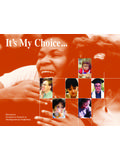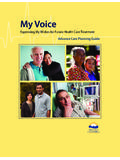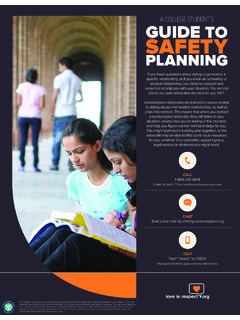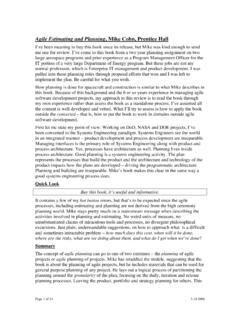Transcription of My Plan: A Guide To Person-Centered Planning
1 My Plan: A Guide To Person-Centered PlanningUsing the National Core Indicator and state data to understandhealth status and the experiences ofpersons with intellectual/developmental disabilitiesserved by the Michigan public mental health systemApril 20161 ContentsI. The Data Barriers and Challenges to Person-Centered Recommendations and Best Person-Centered Planning BackgroundThis brief is one in a series of reports on findings from consumer interviews conducted in Michigan during 2012 as part of the National Core Indicator (NCI) Program.
2 In 2011, Michigan joined the NCI program, which began in 1997 and is now used in over 41 states to provide a standardized way to measure and track indicators for persons with intellectual/ developmental disabilities (I/DD) who are served by the public mental health system. In January 2013, Michigan convened an NCI Advisory Group, which worked in collaboration with the Developmental Disabilities Practice Improvement Team and the Quality Improvement Council to analyze Michigan data and to make recommendations. Five priority areas were identified, which are also NCI indicators: Person-Centered Planning , health, relationships, living arrangements and employment.
3 This brief addresses Person-Centered Planning . The indicators summarize the surveyed results from personal interviews with individuals with I/DD and the background information provided by the community mental health system. Information from these interviews is helpful to understanding the experience of individuals served, and their outcomes can be used to compare Michigan s outcomes to other states. The consumer interview and family survey results can be found at: information gleaned from the NCI data is used to identify areas for continued improvement in the delivery of public mental health services.
4 Stakeholder discussion and analysis of the NCI resulted in identification of several areas of opportunity for improvement. These include: Employment: Improving employment outcomes. Living Arrangements: Increasing the number of individuals who have and who exercise choice over where and with whom they live, who have privacy and control over their home environment, and feel safe in their home. Health/Wellness: Increasing physical activity and preventive and routine health care to improve health. Person-Centered Planning : Improving the Person-Centered Planning process, which in turn supports all of the above desired outcomes and experiences.
5 Relationships: Increasing individual s connections in their community and supporting their relationships with friends and family (decreasing feelings of loneliness).2 IntroductionThis brief includes a summary of the evolution of the person centered Planning process, expectations for service providers to use the person centered Planning process, the basic tenets and values of the practice, and the current status of the use of person centered Planning in the public mental health system in Michigan. The workgroup identified, and the report includes, a list of the barriers and difficulties to improving outcomes through use of the person centered Planning process as well as recommendations for improving this of the Person-Centered Planning ProcessPerson / Family-Centered Planning (PCP) is a process mandated through the Michigan Mental Health Code (MMHC)
6 For all individuals receiving publicly funded mental health purpose of Michigan s public mental health system is to support adults and children with developmental disabilities, adults with serious mental illness and substance use disorders and children with serious emotional disturbance to live successfully in their communities achieving community inclusion and participation, independence, and productivity. Person-Centered Planning (PCP) enables individuals to achieve their personally defined outcomes. PCP for minors is inclusive of the entire family.
7 A family driven youth guided approach recognizes the importance of family in the lives of children and that supports and services impact the entire family. In the case of minor children, the child and family are the focus of Planning and family members are integral to success of the Planning process. PCP as defined by the MMHC means a process for Planning and supporting the individual receiving services that builds upon the individual s capacity to engage in activities that promote community life and that honors the individual s preferences, choices and abilities.
8 The Person-Centered Planning process involves families, friends, and professionals as the individual desires or requires (MCL (g)). Ultimately, the purpose of Person-Centered Planning is to provide a process for an individual to define the life that he or she wants and what components need to be in place for the individual to have, work toward and achieve that life. 3 Expectations of ProvidersMental health agencies are responsible to ensure that a Person-Centered Planning process is used to develop a written individual plan of services (IPOS) in partnership with the person served, their family, friends and other allies important to the person and that they want included in the process.
9 The plan is where meaningful and measureable goals for the person s life are recorded along with the amount, scope and duration of services and supports required to assist the person to work toward and achieve those goals. Services and supports may consist of the array of services provided by the mental health agency, services provided by other community agencies, or supports of family, friends or other individuals important to the person receiving services. The plan is part of the golden thread whereby the needs and desires of the person are reflected in all pre- Planning documents such as intake and needs assessments, reflected in the IPOS as well as all subsequent documents (progress notes, periodic reviews, and other reports).
10 Minimally, the plan must address the persons need for food, shelter, clothing, health care, em-ployment opportunities, education opportunities, legal services, transportation and recreation. Since people s lives change, it is important that the plan reflects current needs, goals and desires. The plan should be modified whenever a person s desires or needs change or an event occurs that would require a change in the services and supports needed or desired by the person. It is critical to note that person centered Planning does more than address the service needs of the person by the mental health agency as developed in an IPOS.

















